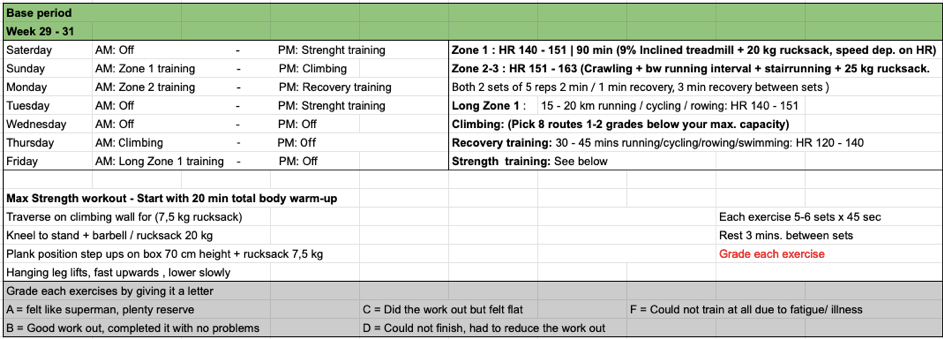We have been working out for quit a few weeks in the basic period. The name says it all, a period in which the foundation is laid of every aspect that will be needed during the year of the 7 summits. In the first few weeks we have emphasized the training of many training hours. The focus was mainly on volume training, in particular on a heart rate within zone 1 / 2. The strength training sessions were still fairly generally based on training aimed at the large muscle groups. In the second half of the base period we will start training more specifically and we will build up the training intensity so that we can eventually move on smoothly to the pre-competition phase in which the heaviest and most training hours will occur.

To take you along in the design of these training schedules, I first want to look more into the deviation of the training content.
If you look closely at the previous training schedule (discussed in blog 5), you can see that there are 4 types of training forms in the weekly plan:
Type 1. Endurance training zone 1, type 2. Endurance training zone 2, type 3. Strength training, type 4. Climb specific training.
To further expand this schedule, we will introduce the following step for each type of training:
Endurance training zone 1: The amount of training hours (volume) is built up with 5-10% per week and during these training sessions we will introduce the wearing of extra weight. We start the first week with a backpack with a capacity of 10% of your body weight and expand that further by 5% per week. (We stop at a weight of 30% of the body weight)
In addition, we will provide a lot of walking / hiking time in hilly terrain. You can also simulate this by taking stairs, for example.
Endurance training zone 2: Within this training zone we apply the same structure as in the zone 1 training and we will also look for the threshold of zone 3. This means that we will introduce a small interval training here and there. The feeling of incomplete recovery will slowly build up.
Strength training: This type of training remains the same in volume and we will expand with more specific exercises and a somewhat heavier intensity. Jur indicated on average that he experienced many B’s and C’s while completing strength training, which meant that he felt exhausted up to 70% of his maximum power. We are slowly increasing that to 80%.
Climb-specific training: We extend these training courses in both duration and difficulty. Here too we will expand the training by 5% on both aspects.
Boris and Jur will be going to Khan Tengri in a little under a month. We will continue building the training up to a week of departure. The week before departure we plan a recovery week in which all current training sessions will be reduced by around 40-50%.
See below the details of the training schedule for the coming 3 weeks.


The expedition on Khan Tengri is one in which we can test all kinds of important aspects. Sending both men a little over-trained on an expedition is a conscious choice. Physically, the body will have to get used to a limited recovery time and perform while being in the red for a long time. We want to lay that foundation here. This also gives a more realistic picture of the body’s responses to various food and medication experiments that we are going to introduce while being fatigued.
Mentally this is also an important aspect to practice because it will be of great importance that both get to know their body as well as possible in those circumstances. They want to learn which body signals mean what and build confidence in the endurance of both their bodies and their minds. And last but not least, it will be a way to get to know each other better and to accept each other in more difficult times.
It is getting closer now, so it’s time to get more serious now!
Do it yourself!
Increasing the training is something you do with a lot of consciousness. Continue to use your own observations and measurements from previous training sessions. You want to find the right balance between heavy training but not over-training. When you start to brag yourself by measuring yourself against others or by ignoring signals from your body, there is a danger that you will break down the body instead of building it up. So ensure a carefully designed plan.
If you are not completely sure about your own training schedule and you would like some advice, feel free to ask your questions in the comments below or send me an email with your schedule to; [email protected]


